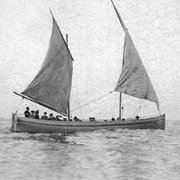

dickrd
Members-
Posts
466 -
Joined
-
Last visited
Profile Information
-
Gender
Male
-
Location
UK
Recent Profile Visitors
4,965 profile views
dickrd's Achievements

Established Member (3/9)
1.1k
Reputation
-
I think that was just a bit later in the war. If you have the Shipcraft book then a drawing of the Hotchkiss MG is bottom right of page 79.
-
We are talking about the Hotchkiss .303" machine gun on Burdock in 1941. @Faraway See page 183 of Lambert's drawings book re British Naval Trawlers and Drifters equipment or Google it.
-
Sorry, we were discussing guns at the time of that earlier posting of mine. The record says she had two rails and 4 throwers and stowage for 60 DCs at the time in question.
-
An interesting train of thought in your post. As it happens I took a photo of the north bank of the Clyde opposite Greenock when passing one slightly murky morning a couple of years ago. Viewed from the height of Furious (I was slightly higher) ANY brown would be too much!
-
Late 1940 Ilex was wearing a very fussy patterned camouflage scheme that looked in some ways a bit like this 1942 one on USS Ingraham in 1942: The (private) photo I have of her at this time was taken in very strong sunlight at Alexandria so it is hard to be precisely sure of the tones: I suspect 507A for the darks, 507C for the lights and then all the darks edged in a thin line of white. A possible alternative interpretation is a 50/50 mix of 507A & 507C for the lights, 507A for the darks and 507C for the thin edging to the darks. No obvious modifications to her peacetime appearance. There is then another (private) photo taken during March 1941 from HMAS Perth. By a process of elimination it is thought to be of Ilex. It is a slightly distant shot of the destroyer's port quarter. If it is Ilex it shows her to be by then in a more normal Alexandria type scheme of 507A & C. This is what that looked like (the darks were not black): Some details of the pattern are not visible in the photo, particularly the hull at the bow, the upper bridge (lower on the bridge side was definitely light- upper looks dark) and the forward funnel. Modifications: mainmast (aft) removed and a new small stump mast with gaff at aft end of searchlight platform fitted, aft funnel cut down and I think the forward one also. (Still had both sets of TT's.)
-
@Dave Swindell re Campion, I agree with @robgizlu judging by the b&w photos. I have no actual information.
-
Mimosa may indeed be a better starting point but I am no expert on the intricacies of Flower Class structural details and others may be better placed to advise you. I would imagine that the Hotchiss MGs would have been one each side on the bridge wings, perhaps in the same location where Campion mounted twin Lewis guns:
-
Stick with me Jon, this is a bit involved! We have little hard evidence to go on and so a lot of my thinking is conjecture. As I type this the artist, Bob Pearson, of the illustration of Burdock “late 1941” in the Lambert book has not answered my question (on Facebook) about where he got the idea of the design of her 1941 camouflage pattern from. Since various structural/armament details are incorrect for 1941 and given that the design of the camouflage pattern is to my mind too advanced for that early in the war I would discount his pattern unless some evidence is provided. If he does answer I will edit this post. However he has said earlier in the Facebook thread that he got the yellow from the Snyder & Short RN colour chips set 3. Given that the thread was at that point discussing the yellow, I am going to assume that he got the idea of the blue in his illustration from the S&S chip “Burdock blue” as well although that is a bit lighter than the very dark blue he shows. The Snyder and Short colour chips Set 3 was published in 2003. The idea of a ‘yellow’ in a 1941 RN WW2 camouflage scheme always seemed so outlandish to me that it seemed unlikely that S&S would simply have made it up. The idea had to have come from somewhere. A few years back I asked John Snyder where the paint samples they used to create their series came from and the answer was Alan Raven. Alan Raven did not include an illustration of Burdock in this scheme in his four volume Warship Perspectives series published 2000-2003. However Alan mentioned the sources for his books one of which was a former Royal Marine officer named Groves (see Warship Perspectives Vol. 1, pages 4 & 5). During the course of WW2 Groves is said to have taken a special interest in ship colours, to have collected a great deal of data and to have obtained actual paint samples from the paint lockers of individual ships. He also had a collection of small scale models painted in their correct colours which Groves allowed Alan to see. Groves served on the cruiser Devonshire from late 1940 to early 1942. Devonshire joined the South Atlantic Command mid October 1941 and having checked their respective movements there was opportunity for Groves to have visited Burdock when both ships were at Freetown at the same time in late October, on 28th November and quite possibly late December. Three options therefore seem to present themselves as possible. Best case, Groves’ gave Alan his paint samples and it is actual contemporary paint samples from Burdock’s paint locker that S&S copied; second best case, Groves do not part with his originals but Raven mixed paint samples to match by eye whilst with Groves and passed his matches on to S&S; worst case, Raven mixed paint samples from memory at a later date. I am assuming that there was no model of Burdock in Groves’ collection otherwise surely Alan would have included an illustration of Burdock in his books given that the colour scheme was so unusual. Anyhow I thought no more of the S&S chip until a decade or more back when I was able to copy a small collection of Groves’ wartime illustrations. As the ships’ schemes depicted in them tend not to feature in Alan’s books I guess that Alan never had sight of these. Amongst them was an illustration of a Freetown-based V&W in Dec 1941 which Groves depicted with an orange sort of colour in the mix of paint colours: In his notes Groves describes it as buff. Intriguing: why would such a colour be included in the palette of a seagoing camouflage scheme? Back to Burdock. Burdock completed March 1941 and left the UK to join the Freetown escort force after workup that Spring. As far as I can quickly see from her movements she never came back to the UK later that year. The MS&B range of camouflage paints were in their infancy early 1941 and were in any case then only available to ships painting in Leamington-designed Admiralty disruptive schemes. So I think the idea of MS1 as the base colour on her that year is very unlikely. My guess is that she would have completed and worked up in HFG and then repainted to a local camouflage scheme once she got to Freetown. The basic scheme for the South Atlantic Command at that time was dark grey hull/light grey upperworks. So that is what I would expect to find Freetown-based ships wearing unless painted in some amateur pattern designed by their crew. There are indeed 1941 photos of corvettes in the Freetown escort force with dark hull and light upperworks. However what is possibly relevant is that in one of them, Bergamot and Lavender visiting Rio in October 1941, the light of their upperworks looks darker than 507C which puzzled me: OK, it could be all sorts of things to do with the how the photo was taken and later reproduced and printed. It could be the 50/50 mix of 507A & 507C. If it was the Primrose yellow of the peacetime East Indies livery/the “Burdock yellow” of the S&S chip then I would have expected it to come out darker given the orthochromatic film of the time. But buff often behaved somewhat more normally. Again I thought no more of all this until the chance coincidence of your question to me here and the receipt a bit over a week ago of a pretty photo taken by someone at sea out in the Atlantic west of Africa: There is/was a Saharan dust storm blowing and the cloud was making its way across the ocean towards Florida. Perhaps a 1941 dust storm is the explanation for the “buff” on the V&W and perhaps buff, or in Burdock’s case perhaps primrose yellow, was on some Freetown-based corvettes for the same reason for a time as well? As for the “Burdock blue” we can only guess. Maybe it was some local purchase/mix or maybe by late 1941 things on the paint supply front were a bit more relaxed and some B5 had been shipped overseas. So all a bit tenuous and based on not much evidence and open to criticism from all sorts of angles. But I think if I was modelling Burdock I would be tempted to add a bit of colour and variety to my collection and do her in a dark hull/ light upperworks scheme with either a B5 blue or 507A hull and either buff or primrose yellow upperworks . Either way I’d label it as speculative and suggest camouflage during the period of a Saharan dust storm as the excuse! Best wishes
-
I agree that the best bet would be to model Burdock structurally as per Campion, mast forward of the bridge etc. Here is Campion in early 1942: But I don't agree that the lantern would have been fitted on Burdock in anticipation. Everything I have read tells me that that radar fitting was effectively a kit. Burdock completed in March 1941 and left the UK to join the Freetown escort force in May not to return that year. There are 1941 photos of corvettes that completed after Burdock and then joined her in the Freetown force and they have no lanterns.
-
Jon, You move very fast when building whereas research takes time! This is where I have got to so far: Paints: yellow and blue on her in 1941 is credible. MS1 is not. Design of camouflage scheme not credible to me for her in 1941. I would want to see a photo before I believed it. It is it essentially a pattern out of the 1943 edition of CB3098R. Structure: You need to distinguish her appearance in 1941 from 1942 plus. Her twin sister Campion completed a four months after her at the same shipyard and had that little windowed bridge cabin originally. RN records show she had no radar throughout 1941. RN records show her armament throughout 1941 was 1 x 4", I x 2pdr and 2 x Hotchkiss MGs - nothing else. (She would have been near bottom of the priority list for scarce Oerlikons in 1941 in any case.) I will let you know my full thought process in relation to the colours and pattern of the camouflage scheme when I have completed my digging. Best wishes.
-

HMS Tiger (C20) what color was she. White? Light Grey?
dickrd replied to gamevender's topic in Maritime Cold War to 1990
Thank you for taking the time to set your case out in full. I am unconvinced though I’m afraid. Whilst I would agree that 507C had a slight blue element in its mix I’m not sure that I would describe the printed 507C swatch in CAFO 679/42 as a light blue. But we all perceive colour differently and the colours in that CAFO can appear different in different lighting conditions and between different copies (and on different computer screens): Setting the ink-printed CAFO 679/42 aside, an actual paint swatch of 507C in the Admiralty Library is not a light blue. Nor is 507C represented by a light blue sort of colour in any surviving WW2 Leamington camouflage design sheet that I have found or in the artwork of the Leamington designers. Jamie and I and others exhaustively researched inter-war and WW2 era 507C for his Colourcoats paint range a few years back and we did not find it to have been a light blue. Re CB3098R/54 you were unsure whether the G35 notation related to tone as per the later WW2 B&G series paints. This from CB3098R/54 answers that I think. The key phrase is “…similar in specification to DNC M/73 (ie 4941C) but with a reflection factor of 35 per cent...” and the key word there being “but”: That being so we should be able to agree that this G35 paint cannot have been the same shade as G45/507C = Kingcombe’s Pattern 4941 LAG. G35 would have been considerably darker, almost WW2 MS4 in tone. RN ships 1949 – 1959 were manifestly not painted with a tone of weatherworks paint as dark as 35% RF. My interpretation of CB3098/54 is that it is saying that G35 is not the paint that ships were actually wearing then but the ideal theoretical camouflage paint for war. My eyes see (and saw) the G35 ink swatch in CB3098/54 as a grey sort of colour rather than a blue (I have seen the original more than once): Re 1959 plus, I must have started going to Navy Days in the mid 1960’s and, although human memories of such things as colour can be very unreliable, I simply don’t recall the RN ships then and into the 1970’s having the sort of light blue appearance of BS381C No. 697 LAG. We can see what an overall coat of BS381C No. 697 LAG looks like on a ship today as Cavalier is (for reasons that are another story) painted in it: Whereas this I feel is representative of the sort of appearance of the paint in use on her in 1971, albeit on a somewhat grey day: Re Scale Models January 1973, I have gone through every page of that issue and can find no trace of the article you refer to. Do you have the details correct: I would in principle want to see BS381C No 697 associated with 0442/220/2026 in an official document rather than modelling magazine but it would be useful to know the name of author of article. As things currently stand for me, whatever the paint Tiger and her sister Lion were in at the time in question I don’t see it as having had the light blue appearance of BS381C No 697 LAG. Photo after photo, and films, turn up a light grey sort of colour: As with WW2 era 507C and with today’s Light Weatherworks Grey, I envisage it as having been a slightly chameleon sort of colour that can appear almost metallic grey at times but with a very small element of blue in the paint mix that comes out in other lighting conditions. Those that I have discussed the post WW2 RN light greys with over the years have suggested various different timelines and orders of the use of the paints in their versions of the story. But to my mind nothing ever quite tallies with what can be found in the archives and the visual record. For me it’s a bit like trying to do a jigsaw puzzle when you don’t have the boxtop illustration to guide you plus you don’t have all the pieces! -
Ah, I think you have selected an image of the south side of Flotta which has those cliffs. I cannot quite put my finger on where I read it now but the Flotta scheme was a response to the spy hysteria that swept the country in early 1940. The aim of the scheme was to disguise major units of the Home Fleet whilst at Scapa Flow from imagined German spys in Kirkwall. The main fleet anchorage was NNE of Flotta and Kirkwall further on in the same direction beyond that. So the backdrop to the anchorage when viewed from Kirkwall was the NE arm of Flotta which was a bit less dramatic and which looks more like this (although this particular image shows the south side of that arm): It is this layer-cake palette with lots of brown over a small amount of green over a small amount of grey at the waters edge that has coloured my thinking. But a lot would depend on precisely where Rodney was as I think that there might have been more green in the backdrop further west along the north side of Flotta.
-

HMS Tiger (C20) what color was she. White? Light Grey?
dickrd replied to gamevender's topic in Maritime Cold War to 1990
"....but I agree that a change in specification doesn't necessarily mean that the colour changed. I took the reference from the Memo I refer to below." As with many such background briefing summaries written many years after the events referred to and simplifying the story somewhat for the benefit of 1975 reader, the wording used in SHHC Memo 15/75 is slightly loose. AFO 900/64 makes it crystal clear. "Having had another rummage....and 0442/220-2024 (Five Gallon). All are to DG Ships 5957. OK, that takes that shade to 1971/72 then which is two or so years after Plymouth in 1969 . I'm afraid that my collection of DCIs expires at the end of 1969. Need more time at the archives...! "I have always been under the impression that Light Admiralty Grey was the main post war Weatherwork colour...." Yes*, but what the RN called Light Admiralty Grey was not the same shade as the (civilian) BS381C shade Light Admiralty Grey. At one point the Admiralty tried (but failed) to get the BSI to drop the word Admiralty from their name. ".... and that Light Weatherwork Grey only came along sometime around 1980." Presumably because that is when it appeared in the BS colour charts? Or have you any DCI's from that sort of time that mentions it? "Do you have a copy of the contents of ADM 281/204 Lecture Notes 'New Paints for Old' of January 1949?" Yes. I think the key paragraph in it for our purposes is the first full one on page 3 which should be read alongside the second illustration "Table 2". Pattern 4941 Light Admiralty Grey was the same shade as 507C. * To those of us of a certain age "main" feels right. But we are now in 2025, 80 years after the war ended. For at least the last 45 years (maybe more) we both think Light Weatherwork Grey has been the RN's weatherwork light grey. Perhaps we need to adjust our adjective to keep up with the passage of time! -

HMS Tiger (C20) what color was she. White? Light Grey?
dickrd replied to gamevender's topic in Maritime Cold War to 1990
"I'm afraid not, but I do know that Light Weatherwork Grey No.676 was introduced into BS 381C as a new colour in the 1980 edition..... " I think that BS381C introductions of paint colours often lagged some time behind the dates of RN introductions and in some cases RN paint shades never became BS381C colours. ("as was Dark Weatherwork Grey No.697") (Typo for No. 677). "I have always assumed that these were replacements for Light Admiralty Grey No.697"..... My working assumption is that Light Admiralty Grey No 697 as we know it today was not a shade of weatherworks light grey topcoat used by the RN. However it was specified for and used on internal (electrical/electronic etc) cabinets and machinery but also occasionally externally on items such as aerials. Externally it visibly contrasted with the light grey of the weatherworks. "As a paint specification, Light Grey AP 10621 to DNC/M/80 was replaced by Weatherwork paints to Specification DG Ships 5957 in early 1964." I suspect that you are referring to AFO 900/64 here. But to make sure that we are on the same page, do you agree that this was purely a renumbering exercise though? The technical content of paint itself, and so the shade, did not change. AFO 900/64 also makes it clear that 0442/220/2026, the NATO stores number, was AP10621. "Pattern 0442/220/2026 was still in use in January 1975." 1975 is safely into the RN Light Weatherwork Grey to BS381C No 676 era which I can trace back to at least 1969 on Plymouth. Can you say how you know it was still in use in 1975? Was there evidence of another light grey in use at the same time in 1975? -

HMS Tiger (C20) what color was she. White? Light Grey?
dickrd replied to gamevender's topic in Maritime Cold War to 1990
Concur. Shade was defined as "a combination of colour and tone" (CB3098R/43 & 45). So it could be that the colour was the same but the tone was different or vice versa (or even both different). Have you found anything official to say exactly when Light Weatherwork Grey was introduced replace AP 10621?







